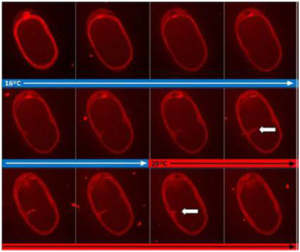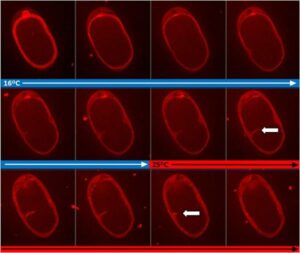Temperature control for thermo-sensitive ion channels experiments
To sense cold and hot temperatures is vital for all organisms in order to adapt to their environment. The cellular pathways ensuring thermo-sensation are well conserved through evolution, and consist of a set of specialized temperature-gated ion channels highly sensitive to a wide range of hot or cold temperatures.
With its precise and ultra-fast temperature switch, CherryTemp offers you the possibility to activate thermo-sensitive ion channels while visualizing the downstream cellular effects with microscopy.
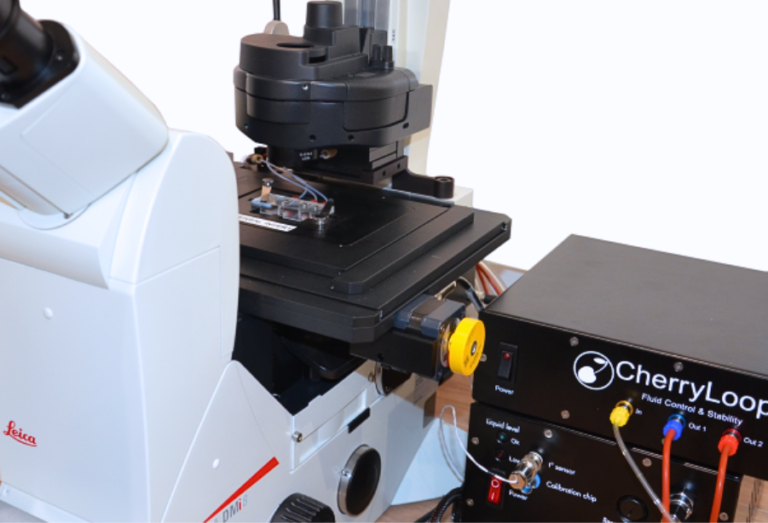
Temperature sensitive ion channels
Ion channel opens to a specific signal to allow ions to go inside or outside of the cell. The specific signal can be electric, mechanic, molecular, heat or cold. There are several types of temperature-gated ion channels. In mammals, Transient Receptor Potential channels are calcium or magnesium permissive ion channels mainly expressed in peripheral nerves terminals and keratinocytes, where they participate in thermo-sensation. Other Calcium channels are regulated indirectly by temperature, they participate to Ca2+ signals in the cells, which are crucial for several dynamic cellular pathways such as vesicles secretion, or muscle cell contraction.
Ultra fast temperature shift device for in vitro experiments under microscopy
Heat thermo-sensistive ion channels
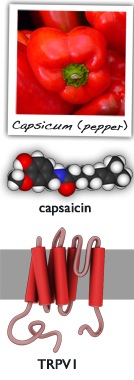
There are 4 Transient Receptor Potential Vanilloid channels: TRPV1 was the first identified in this family, and was first cloned in C. elegans (Colbert et al., 1997). It responds to capsaicin, the chili component responsible for the burning sensation. TRPV1 is expressed in keratinocytes and in the pain nervous fibers in the skin, and acts as a sensor for noxious heat. Temperatures above >42C trigger TRPV1 activation leading to an entry of Ca2+ inside the keratinocytes and an indirect activation of P2X3 receptors on pain nervous fibres. TRPV1 is readily activated by pro-inflammatory signals making the channel open even at 37C. TRPV2 is sensitive to temperature above 52C, and is expressed in fast pain transmission fibers, underlining its role in survival reflexes against noxious heat sensor. There are two others heat receptors: TRPV3> 34-38C and TRPV4> 27-35C.
Ion channels sensitive to cold temperature
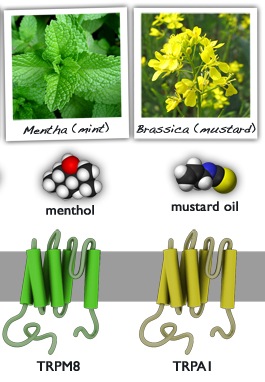
The identification of heat receptors led to the search for cold sensitive receptors. TRPM8 was identified (McKemy et al., 2002) it responds to temperature ranging from 25 to 28C and is activated by menthol or eucalyptol. TRPA1 is the other identified cold receptor and responds to temperature below 17C. TRPA1 is also activated by mustard oil or wasabi. Indeed, the burning-like sensation provoked by spicy oil resembles the one triggered by noxious cold temperatures. Both TRPM8 and TRPA1 are expressed in pain nervous fibers.
Calcium channels regulated by temperature
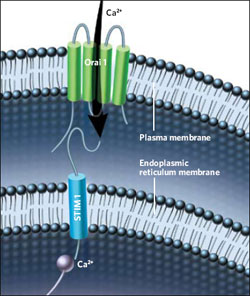
There are two types of calcium ion channels: voltage-gated and ligand-gated. Ca2+ channels participate in striated and cardiac muscle contraction, neurotransmission, cell differentiation and vesicules fusion. Among the voltage-gated ion channel, the T-type Ca2+ channels have been shown to respond both to temperature and voltage (Iftinca et al., 2006). Orai are calcium release-activated calcium channels and are directly regulated by thermo-sensitive proteins. Indeed, Orai activation is controlled by STIM proteins, transmembrane endoplasmic reticulum store proteins, which sense both Ca2+ level and temperature. When Ca2+ levels are low, STIM concentrate at the plasma membrane and activate Orai channels. When temperatures are elevated (>40C), STIM proteins concentrate at the cell membrane but does interact with Orai channels, thus preventing Ca2+ entry, when temperature cool down, the binding between STIM and Orai occurs and calcium can enter the cell (Mancarella et al., 2011).
Temperature gated ion channel studies with CherryTemp
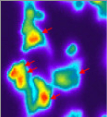
Ion channels activation is linked with highly dynamic and transient cellular processes. The possibility to activate ion channels while visualizing activation of downstream signaling pathways requires an adequate temperature controller. CherryTemp is a dual heater/cooler temperature controller, which allows you to shift from 5 to 45C in 10 seconds, it is very precise, you can program cycle of temperature shift as many time as you need. TRPV ion channels are sensitive to a broad range of temperature, and studying TRPA1 biology requires to stimulate the cells with temperature below ambient, with our system you can test very precisely the property of TRPV while imaging the cells at the microscope. Our system allows you to combine ion channel activation with live-cell imaging.
References
- Colbert HA, Smith TL, Bargmann CI. OSM-9, a novel protein with structural similarity to channels, is required for olfaction, mechanosensation, and olfactory adaptation in C. elegans. J Neurosci 1997.
- Iftinca M, McKay B.E, Snutch T.P, McRory J.E, Turner R.W, Zamponi G.W Temperature dependence of T-type calcium channel gating Cellular neuroscience 2006
- Mancarella S, Wang Y & Gill DL, STIM1 senses both Ca2+ and heat, Nature chemical biology, 2011
- McKemy DD, Neuhausser WM, Julius D. Identification of a cold receptor reveals a general role for TRP channels in thermosensation. Nature 2002.
- Premkumar LS, Abooj M TRP channels and analgesia, Life Sciences, 2013
- Westlund KN, Kochukov MY, Lu Y, McNearney TA, Mol Pain 2010
- S. Ben-Aroya, X. Pan, JD. Boeke, and P. Hieter, Making temperature-sensitive mutants, Methods Enzymol. 2010


